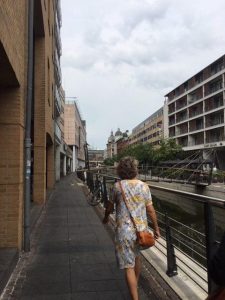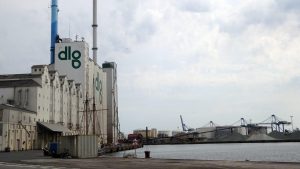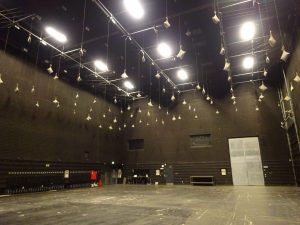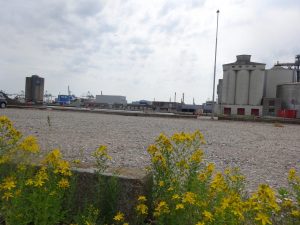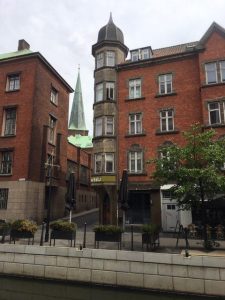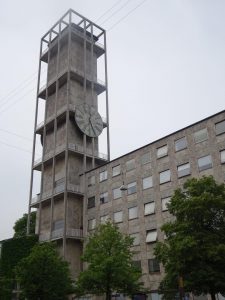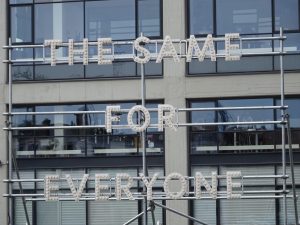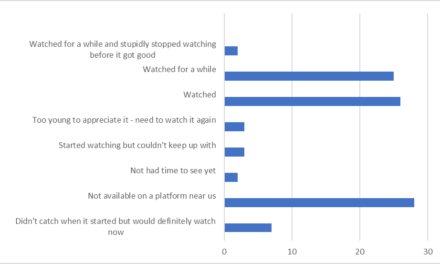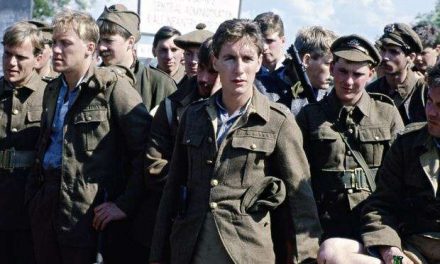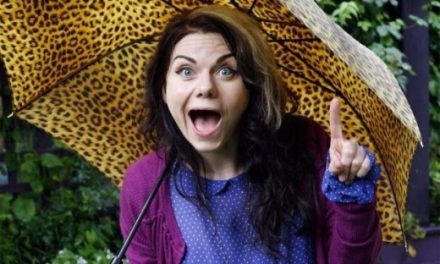Location manager Ulla Malmos knows her way around Aarhus. From the post-industrial landscape down by the harbour to the courthouse on the hill: this is her beat (fig.1). So familiar is she with Denmark’s second largest city that Ulla set a challenging pace for those of us scampering in her wake, as she described in absorbing detail the business of setting the scene for the crime series, Dicte (Dicte-Crime Reporter, 2013-16).
The show combines filming in a studio with on location shooting; Dicte is, as Kim Toft Hansen and Anne Marit Waade tell us, ‘the cornerstone of Jutland media production in Denmark, with very close practical and financial collaboration between the municipality of Aarhus, the broadcaster TV 2, the local film commissioner The West Danish Film Fund and the production company Miso Film with strategic intentions of promoting Aarhus as the regional centre for media production, a metropolis in itself and a tourist attraction’ (2017, 140). This sense of being in Aarhus is central to the story of Dicte Svendsend (Iben Hjejle), a crime reporter returning home following her divorce; and walking in her footsteps and frequenting the places and spaces that Dicte inhabits reconfigures this post-industrial city and transforms viewing pleasures into a spatial phenomena (fig.2 and 3).
As we trailed behind Ulla, trying to keep up with her professional stride, her negotiation of the spatial geography of the city and its public spaces proved illuminating. Darting kamikaze-style across busy interchanges, almost breaking the protocols of the right of way—everything, including the bikes, stops when Ulla crosses the road. It is more than a familiarity with the terrain, and more that she inhabits an imaginary space. Imagining the possibility of a real, physical place to mediate a story.
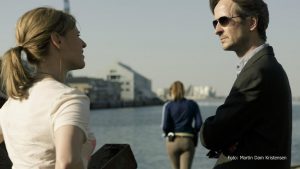
Fig. 3: In the first episode of the crime series ‘Dicte’, a pregnant woman is found dead in the Aarhus Harbour area. Source: www.visitaarhus.com
As we scrambled up grass verges, rather than taking the longer, more sensible, concrete public path to the ARoS Art Museum with its rainbow roof designed by the Danish/Icelandic artist Olafur Eliass, her mapping out of the city doesn’t respect municipal cartographies or the practicalities of the built urban environment. Instead it sees Aarhus as an imagined location, the atmosphere for a story, and offers a secular pilgrimage for the TV viewer/fan as an everyday practice of television consumption.
Textures and the ambience of a place matter more, places defined and altered through the impact of being put in the frame. We stood in the cavernous empty studio space where the built sets for Dicte’s home and editorial offices once stood (fig.4), we stared at desolate industrial landscapes (fig.5) and peered up at the exterior of a flat we couldn’t hope to enter (fig.6).
We could only imagine. But that’s surely the point. It’s about being able to call to mind Dicte visiting the City Hall (with its recognisable modernism designed by Arne Jacobsen and Erik Møller) (fig.7), while investigating a crime, as we physically walk across the same ceramic tile floors. Displacement and dislocation, being physically present and in the proximity, define the on-location tourist experience. We were here, but imagining being somewhere else, in search of traces left behind, searching for the ‘authentic’ Dicte in the phenomenology of the streets.
The location tour is about spaces of transformation, of looking at the city with different eyes, but also seeing the physical transformations in the landscapes, often situated at the periphery, where filming takes place. Where the studio is located, for example, is in an area undergoing substantial redevelopment; but the experience of walking in the footsteps of Dicte is of seeing a city being transformed into creative spaces and cultural capital. As the European Capital of Culture in 2017 Aarhus has invested a great deal in cultural content to improve its cultural stock. It has of late been consumed with city branding, urban renewal and its competitive position, as Aarhus puts itself on the global map of culture (fig.8). Locating a television text in this specific local geography, creating a Danish crime drama for global networks of transnational TV flow, belongs to that ambition.
According to Ulla, being a location manager involves more than finding the right apartment, picturesque house in the country, or perfect spot by the harbour from which to launch a car into the sea. Which they did three times on Dicte and apparently it’s not that hard. All you need is a car double, a body double, a team of divers and a crane. This is the kind of logistical challenge Ulla loves.
But not all scenes and locations are as easy to manage. Her role is essentially that of an intermediary, translating the ideas of the screenwriter and the director into the reality of a set or location. Directors, it would seem, can be a tad vague on these details. The next step is to negotiate with the people who might live or work in that location to let a bunch of complete strangers into their home, office or business to film some kind of action that may or may not show their place in a good light.
There is a moral dimension, an ethics to finding the right location. One particular location in an upcoming shoot is weighing somewhat heavily on Ulla’s mind because it involves a religious setting and a sex scene (without penetration) that is central to the plot. Fortunately–as she tells us over a beer –this is also a redemptive act and she’s hoping that will be enough to convince the owners of the establishment. Ulla’s role as an intermediary often involves the tricky ethics involved in negotiations like these.
Ulla cares greatly about the impact her productions might have on people’s lives—and on her on-going relationships with the people of her home town and country, but also the impact on the physical environment. As we were taking in the atmosphere of the city, looking for actual evidence that Dicte was once where we now stood, Ulla is about making sure that her productions leave no physical trace behind them. She will be the one at the end of the day picking up the cigarette butts dropped by the crew, sweeping the crumbs off the marble floor, or organising for an insurance claim to replace a heritage door that has accidentally been chipped. It’s another reminder of the world of the imagination, where it must appear as if the production was never there.
But there’s an upside too. Ulla now owns a number of properties that she rents out, a spin-off from the great locations she has found – and then bought. And the designer props nobody wants? Well, they too have found a home with Ulla who has clearly played a vital role in the regeneration of the post-industrial landscape of Aarhus.
Sue Turnbull is Senior Professor in Communication and Media at the University of Wollongong, Australia.
Janet McCabe is Senior Lecturer in Film and Television Studies at Birkbeck, University of London.
Reference:
Hansen KT and AM Waade (2017) Locating Nordic Noir: From Beck to The Bridge. London: Palgrave Macmillan.


